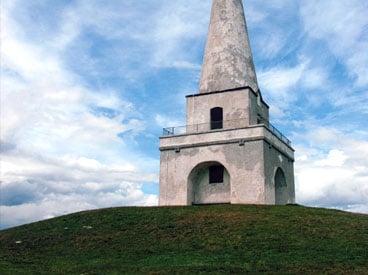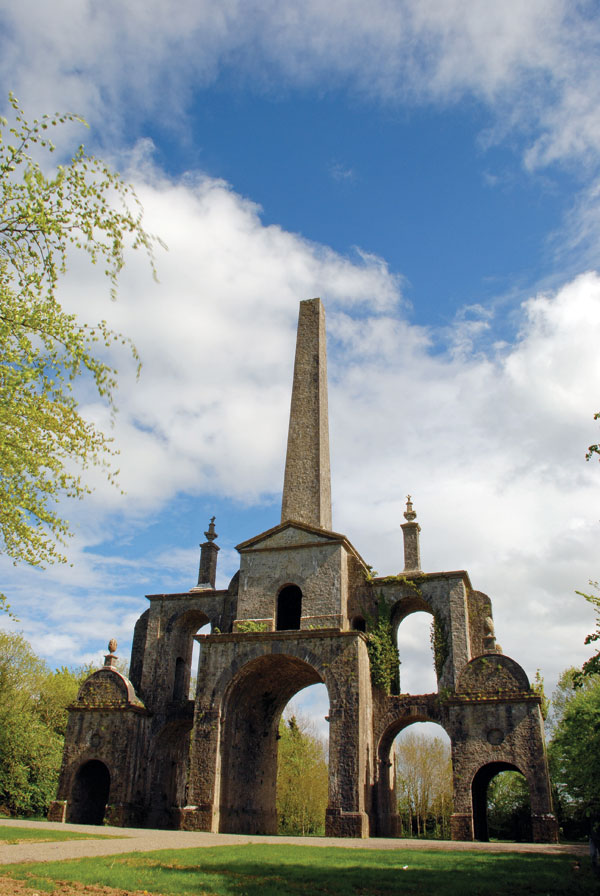I am no exception—the man who would become my father left Ireland still in his mother’s womb; she had a thoroughly Irish last name while the man who had sired her unborn child had an Anglo last name. That Anglo surname appears fourteen times in A Genealogical and Heraldic History of the Landed Gentry of Ireland by Sir Bernard Burke (1899), the Gaelic name not once. If the two had married, and they didn’t—but that’s another whole story—I would not be sitting here in America with my Gaelic name, writing about Irish folly buildings.
But back to famine times, and landlords building follies, and the curious question, why. Why did they do it? What made them think this was an appropriate use of resources? Imagine one: let’s say he’s not an absentee landlord but a man who lives most of the time on his land, and a little in Dublin; he is well aware of the famine ravaging the country but was not bred to see himself as a cause of it, and he never will. In his drawing room, he moves the curtain at the window just enough to see, huddled around the back of the house, the men and women and children come to beg—hollow-eyed and gaunt, the walking dead—and he thinks, I am being bankrupted, but it’s not a selfish thought, because even as the words unfold in his mind what he’s seeing is that his starving tenants cannot possibly care about his situation. The thought—I am being bankrupted—feels detached, unreal. Irrelevant. And he thinks, Well. We must build something. And as long as he’s at it, it might as well be something very large and very silly.
It’s hard for us, today, to understand those people and why they built follies instead of, say, schools or housing for their tenants. I find their world, and their worldview, so alien that it’s a major imaginative stretch for me to concoct scenarios of what went through their heads. I can offer the rationalizations that they might have offered for making their tenants toil, instead of just feeding them—they would have said that charity in the form of hand-outs was a bad idea, bad for character. Inevitably, though, there was plenty of that kind of charity too; with the vast numbers of hungry people, building projects could not put all of them to work. This may be why some follies are so ambitious and massive—Conolly’s Folly, for instance, took hundreds of men to build.
But why frivolous follies instead of schools and housing? The answer hangs, floating, in the immense gulf between the rulers and the ruled in that time and place. The landlords were magnificently clueless, it seems to me—it’s as if it just didn’t occur to them that building, for example, sturdy houses for their tenants might be a good idea. There was of course the risk that if the tenants got very much they would want more. And follies were fashionable, and grand, and building them was an affirmation of fashion and grandeur, at a time when the social order was powerfully under threat. Call it denial, a stubborn insistence that nothing had changed, that nothing would change. The building of follies seems, at some level, desperate. Extreme, baffling times call for extreme, baffling buildings.
As outrageous as the follies seem, they start to come a bit more into proportion when viewed in the context of the estates they belonged to, which were like little countries unto themselves. The household at Castletown—home of Conolly’s folly—regularly fed over 80 people a night, between servants and family. The house and its outbuildings had more than 90 hearths which burned 300 tons of coal per year; lighting Castletown used about 2400 pounds of candles each year. The estate’s dairy produced roughly 8,000 gallons of milk annually, and the chickens produced over 10,000 eggs, although this wasn’t enough and they had to buy 6,000 more. The staff at a typical Irish country house had, at the top, the steward, butler, and housekeeper, and beneath them were valets, footmen, pantry boys, the gentleman of the horse, an army of maids, a full-time wet nurse. There were also the servants who worked outside—laborers, lodgekeepers, the brewer, the miller, the shepherd, the grooms and stablehands, wheelwrights, smiths, etc. The numbers employed would swell during periods of hardship—time, then, for a new folly or two.
The aristocracy saw class distinctions as ordained, and crucial. And they would never have wondered, as we do, what the laboring classes thought of the folly-building schemes their superiors cooked up. The story of Emily Lennox Fitzgerald, aka Lady Kildare, whose family built Conolly’s Folly, illustrates this reality. In 1767, she decided to hire a tutor for her children, a well-educated, bright young Scotsman called William Ogilvie. She’d never employed such a person before—he was not an ordinary servant, but what was he?—and Emily struggled, wretchedly, to decide which would be appropriate to provide him, tallow candles or beeswax candles. Oh dilemma! She fretted, she wrote letters to her relatives, she begged for advice. Such were the kinds of things these people worried about—small wonder they didn’t see anything incongruous, or untoward, about commissioning follies. (Emily settled on starting Ogilvie with tallow candles, but later had an affair with him and after her husband’s death she went on, somewhat scandalously, to marry him; presumably he moved up to beeswax.)
Driving around Ireland with Frank, this is what I see. Chinese take-away in a village high street, between the butcher and the pub. Treeless new suburban housing estates built on former pastures. Wind turbines, motorways, billboards advertising “sliding wardrobes” to storage-craving homeowners. Satellite dishes, sprouting from the sides of cottages. It would be crass and patronizing of me to resent, in the least, Ireland’s right to be its ordinary, modern self, and I don’t. But as an outsider, I bring with me certain pictures of the place that I have to admit, if I’m truthful, include impressionistic brushstrokes, blurry-soft, pleasantly colored. Maybe being a good traveler does not mean denying those pictures, but being open enough to see them in a new light.
One sight in modern Ireland saddens me, though, and I can’t get around it. During the Celtic Tiger years—that decade before the economy crashed, when Ireland was the Silicon Valley of Europe and Irish young professionals who had left came flocking back—some people built themselves new houses. These stand on plain green lawns with bright black asphalt driveways, and though neither house nor lawn nor driveway is large by American standards, the houses seem big, and disturbing in the way they violate the Irish architectural vernacular. Some violate it subtly, others more blatantly. They are like pebble-stucco, lace-curtain cottages on steroids. Many have For Sale signs. Even when they don’t, they have an embarrassed look about them. They are often unoccupied, and the saddest of all are half-built, with scaffolding in place and piles of block and sand lying around but no one working on them.
Frank does not live in one of these, but in Howth, where he grew up, close enough to Dublin that it is now a busy suburb but still feels rural and pretty, which it owes to its seaside location on a peninsula at the head of Dublin Bay. As we drive around looking for follies, I tease him that with his nascent chauffeuring career he is giving new meaning to the investment term “diversification,” and he laughs. He is remarkably good-natured, seems naturally unflappable. He shrugs, says he’s waiting, looking ahead, that it’s the only thing to do. We talk about resilience and resourcefulness, how these are the qualities that serve us most crucially, no matter our life or situation.
In the car, I sit behind him, with a view of the back of his head, which bops in a jaunty way as he talks. His hair is sandy-brown and clipped short to minimize the fact that there isn’t much of it, and his neck has a touch of pink from razor-burn. He says he never uses the SatNav except when lost; instead, as we drive along, he pretends to be the SatNav, imitating its nasally-robotic but distinctly female, American voice—Irish people love doing American accents—“Turrrn right at the traaaffic cirrrcle,” he drones, and he’s cracking himself up because traffic circle seems so peculiar if you’ve always called them roundabouts. As we strike out on foot in search of this or that folly, he’s a great sport, stomping through long grass in his good shoes. He could stay in the car, but he doesn’t want to. He wants to see these crazy things.
Frank knew nothing about follies before I introduced him, although he knew some of the estates on my list because they are places he plays golf. It’s a Sunday, and we see lots of golfers; I tell him I hope I’m not keeping him from what he would normally be doing on a Sunday, meaning church and family, and maybe golf too. He tells me he’s Catholic but mostly non-observant, repulsed by the abuse scandals that have rocked the Church in Ireland. He seems anxious to explain, and he glances up at me frequently in the rearview mirror, his warm eyes twinkling. The abuse scandals have made him think about other things—the way priests can’t marry, and the way women’s roles are limited. He lets go of the steering wheel and waves his hands around, gesture of frustration, disenchantment. As his hand settles on the wheel again, I see, for a moment, his wedding band, glinting gold. The ring is tight, in that middle-aged-man way—his fingers have filled out a little, while the band has stayed the same size.
Frank has been to the U.S. a couple of times, once with his college rugby team all the way to California. He’d like to go again, and he spins his dream itinerary for me in the rearview mirror—it’s ambitious, it’s got everything from the Canadian Rockies to New Orleans to San Francisco, it involves a lot of trains (Europeans, of course they think in terms of trains), but I’m most struck by the fact that it starts with a nice long visit to Boston, and that to Frank, this is possibly the most exciting destination of all. Boston—not that it isn’t a fine city, but no one, apart from the Irish, would see it the way Frank is seeing it, right up there with, say, Provence in springtime. Even philosophical Frank, who makes a science, in his daily life, of moving on and letting go, looks to the past—longs to visit the city the Irish made when they left their homeland long ago.
He would be warmly welcomed, if he found his way to the right bar in the right corner of Boston. Maybe there’s a guidebook—or ought to be—The Irishman’s Boston. With luck, he’d get the same sort of reception that Irish-Americans look for and often find when they visit Ireland. But even as the visiting American embraces his ultra-distant cousin in Cork, or Clare, or Mayo, and looks him in the eye, seeking that flicker of true connection, I wonder if he sees what’s really there, all the history in those eyes. Irish-Americans visiting Ireland bring pride, nostalgia, and curiosity about their heritage, while the Irish they encounter there carry around something much more complicated.
Grudges, for instance. Grudges as old and deep as bog oak, the 5600-year-old wood that lies buried all over Ireland, from a time when the place was covered in trees. It ended up submerged in the peat bogs, where it was preserved by that acidic, oxygen-poor environment, and turned up again as the peat was cut for fuel, and continues to. Artist Helen Conneely has been making sculpture and jewelry out of it for over twenty years in a tiny village in County Westmeath, which sounds like a nice idea except that the Irish have traditionally viewed bog oak with a mixture of bitterness and anger and mostly shame. This was because the poor were forced to turn to it for lumber and fuel since the landlords reserved the standing timber for themselves. Along the edges of the bogs today, waiting for Helen Conneely to come along, loom great dark tangles of twisted bogwood stumps and roots and branches. She drags pieces of it into her old greenhouse-turned-studio, piles it all over the broad shelves that in an ordinary greenhouse would be loaded with plants. The day I stopped there it was raining, and the light was diffuse and lovely, the sound of the rain on the glass soothing and cool. Helen moves with a hopping, bird-like energy except when she’s grinding away with a rasp at a hunk of bogwood, looking for the shape inside it. Her soft brown hair hides her face as she works, her whole body shakes with the motion of her sawing, she is a picture of determination. She has no small task ahead, turning shame into pride. Her website has optimistic copy aimed at an Irish “woman of the modern world, untouched by its worldly ways” who is “effortlessly engaging in her confident freckled beauty” and who is “home again … under a billowing sky, against a wooded horizon, on a carpet of peat bog stretching into the distance.”
Become a Saturday Evening Post member and enjoy unlimited access. Subscribe now





Comments
Two years ago, we were at the Orlando Airportdeparture gate, awaiting take-off for Ireland, my grandfather and grandmother’s birthplace. And then the volcano erupted again. Events have prevented us from rescheduling the trip, and I’m so glad. The article about Ireland’s Follies is wonderful and stirs the wanderlust. We are now researching – again- all the things we want to see in Ireland, and we have added the Follies to our must-see list. Thank you for making us aware of these; we can hardly wait to go.
LOVED your article on the Follies of Ireland. Just made me want to drop everything and go. Thanks for a Follie good time